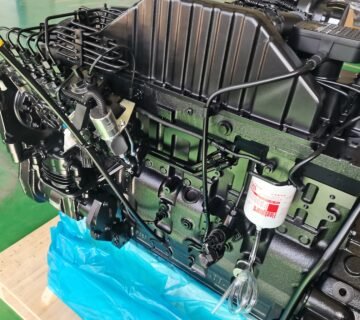Cummins Engines in Military Vehicles: Rugged and Dependable Power for Mission Success
In the high-stakes world of military operations, equipment failure is not an option. From navigating unforgiving terrains to sustaining prolonged missions in hostile environments, military vehicles demand engines that combine brute strength, unwavering reliability, and cutting-edge innovation. For decades, Cummins engines have powered military fleets worldwide, earning a reputation as the gold standard for rugged dependability in defense applications. This article explores why Cummins remains the trusted partner for armed forces and how its engines excel in the most demanding scenarios.

The Uncompromising Demands of Military Operations
Military vehicles face unique challenges: extreme temperatures, corrosive environments, heavy payloads, and the need for rapid response. Whether it’s a Humvee racing through desert dunes, an MRAP (Mine-Resistant Ambush Protected vehicle) deflecting explosives, or a Heavy Equipment Transporter (HET) hauling tanks, the engine is the heart of mission readiness. Cummins engines are purpose-built to meet these challenges head-on, leveraging decades of engineering expertise in military-grade diesel technology.
5 Reasons Cummins Dominates Military Vehicle Engineering
- Battle-Tested Durability
Military engines must survive conditions that would cripple conventional powerplants. Cummins diesel engines are engineered with reinforced blocks, hardened pistons, and advanced filtration systems to combat sand, dust, and moisture. Their ability to operate in temperatures ranging from -40°F to 125°F ensures performance in Arctic missions or Middle Eastern deployments. For example, Cummins’ QSK95 engine, used in heavy transports, undergoes rigorous testing to meet MIL-STD-810G standards for shock, vibration, and electromagnetic resistance—proving its mettle in real-world combat zones.
- Unmatched Torque for Tactical Superiority
In combat, acceleration and towing capacity can mean the difference between life and death. Cummins military engines deliver high torque at low RPMs, enabling vehicles like the JLTV (Joint Light Tactical Vehicle) to climb steep inclines, ford water obstacles, and rapidly evacuate from danger. The Cummins ISV5.0 V8 engine, for instance, powers the JLTV with 275 horsepower and 560 lb-ft of torque, ensuring agility even under heavy armor.
- Fuel Efficiency: Extending Operational Reach
Logistical constraints in remote theaters make fuel efficiency a strategic advantage. Cummins integrates advanced turbocharging and precision fuel injection systems to optimize consumption without sacrificing power. The X15 Military Series engine, for example, reduces fuel use by up to 12% compared to older models, allowing convoys to travel farther between refueling stops—a critical factor in extended missions.
- Simplified Maintenance for Rapid Readiness
Downtime is a luxury military fleets cannot afford. Cummins designs engines with modular components and diagnostic telematics, enabling field technicians to identify and replace parts quickly. The Cummins ADEPT™ (Advanced Diesel Engine Prognostics and Telematics) system predicts maintenance needs, reducing unscheduled repairs. With a global network of service centers and NATO-standard parts, armed forces can maintain readiness anywhere on the planet.
- Compliance with Global Defense Standards
Cummins engines meet stringent military certifications, including NATO STANAG requirements and U.S. military specs like MIL-S-45208. This ensures interoperability with allied forces and guarantees performance under electromagnetic pulses (EMP), chemical exposure, and ballistic threats.
Cummins-Powered Military Vehicles: Frontline Examples
– Humvees & JLTVs: The iconic Humvee relies on Cummins’ 6.7L Turbo Diesel for off-road agility, while the next-gen JLTV uses the ISV5.0 engine to balance armor protection and speed.
– MRAPs: Mine-Resistant Ambush Protected vehicles depend on Cummins QSL9 engines for their blend of horsepower and blast-resistant reliability.
– Heavy Equipment Transporters (HETs): The M1070 HET employs the Cummins QSK19 engine (up to 700 hp) to haul 70-ton Abrams tanks across continents.
– Military Generators: Cummins’ QSK60-powered generators deliver 2.5 MW of electricity to forward operating bases, ensuring critical systems stay online. 
Innovating for the Future of Defense Mobility
Cummins isn’t resting on its legacy. The company is pioneering hybrid-electric propulsion systems to reduce thermal signatures and enhance stealth capabilities. Their Hybrid Power Module (HPM), tested in military prototypes, combines diesel and electric power for silent watch operations and reduced fuel consumption. Additionally, Cummins is advancing hydrogen fuel cell technology for zero-emission reconnaissance vehicles, aligning with global defense sustainability goals.
Why Global Forces Trust Cummins
From the U.S. Army to NATO allies, Cummins engines are chosen for their:
– Proven combat performance in Iraq, Afghanistan, and Ukraine.
– Interchangeable parts across platforms, simplifying logistics.
– Adaptability to biofuels and synthetic lubricants for supply chain flexibility.
– 24/7 global support, including on-site technicians in conflict zones.
Conclusion: Powering Defense, Today and Tomorrow
Cummins engines are more than just components—they’re force multipliers. By delivering rugged dependability, fuel-efficient power, and future-ready innovation, Cummins ensures military vehicles are prepared for any mission, anywhere. As warfare evolves, Cummins continues to set the benchmark for military-grade engine excellence, proving that when lives and missions are on the line, there’s no room for compromise.





No comment